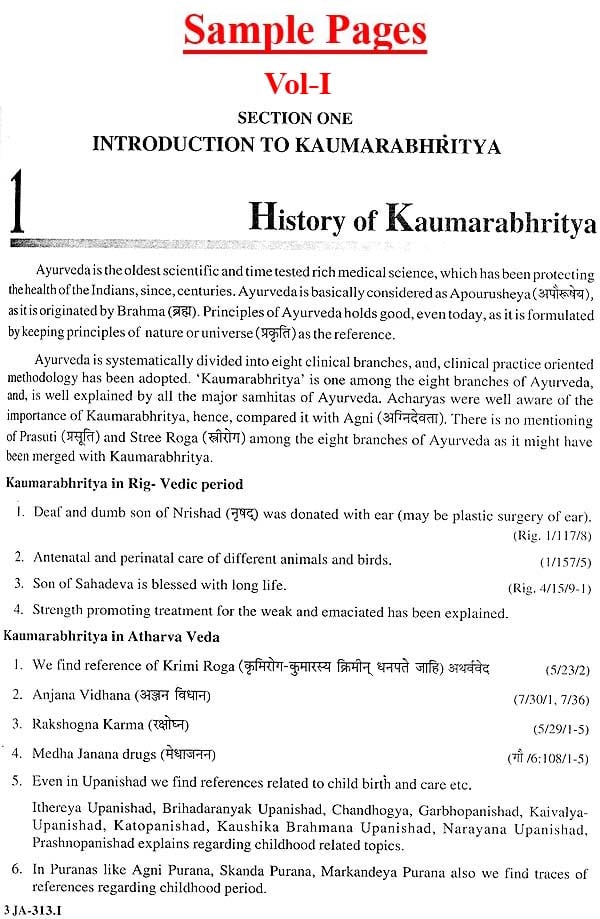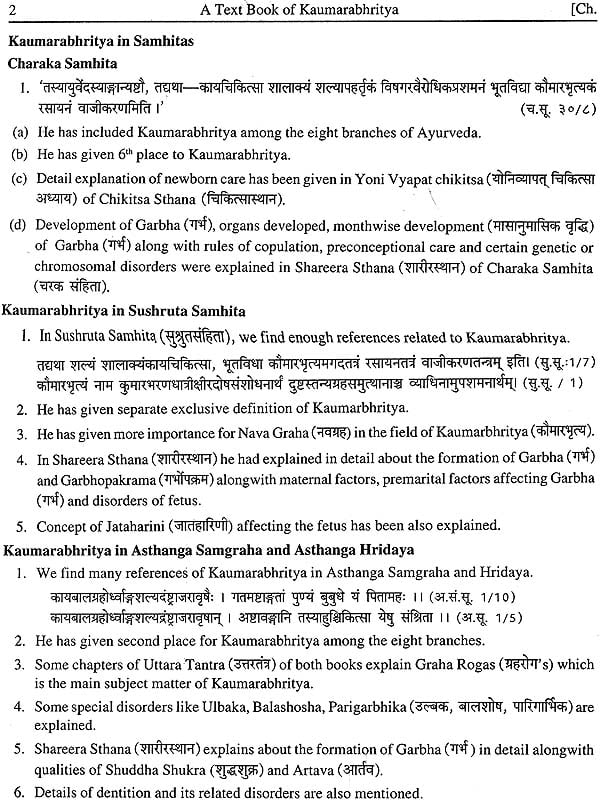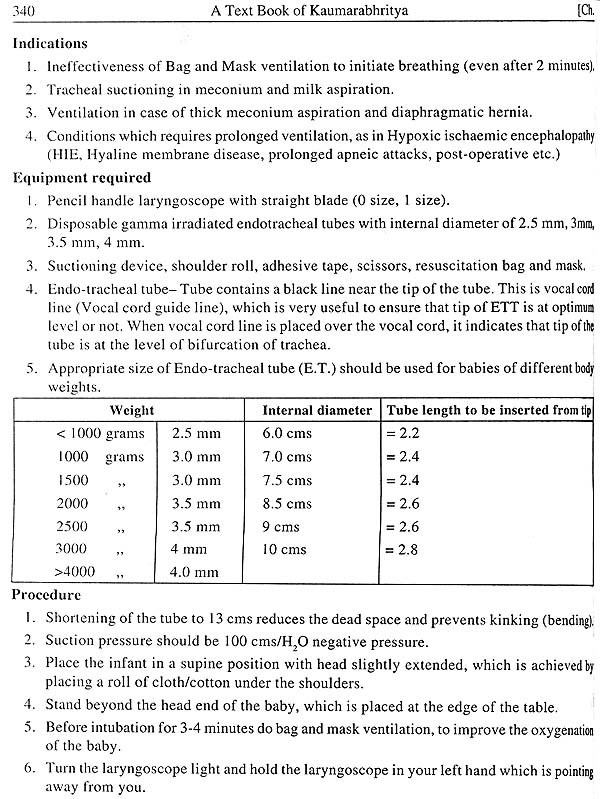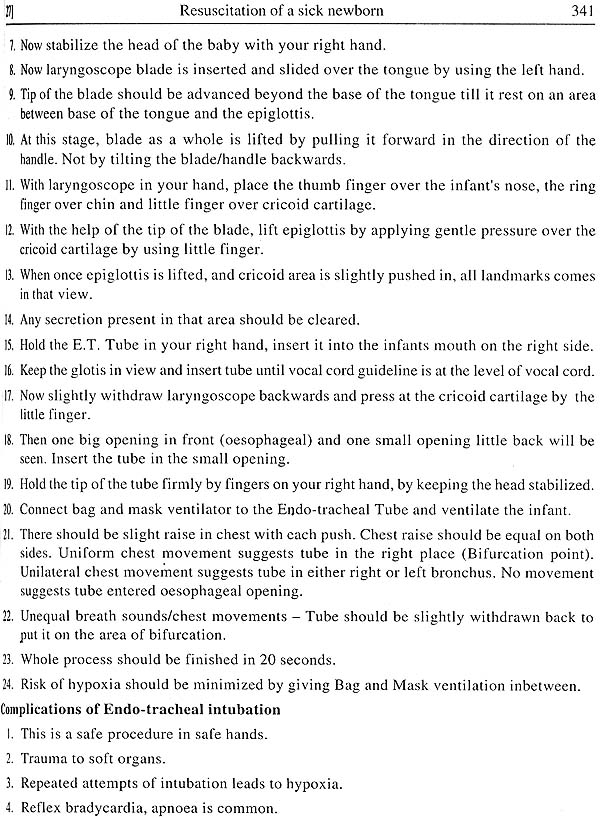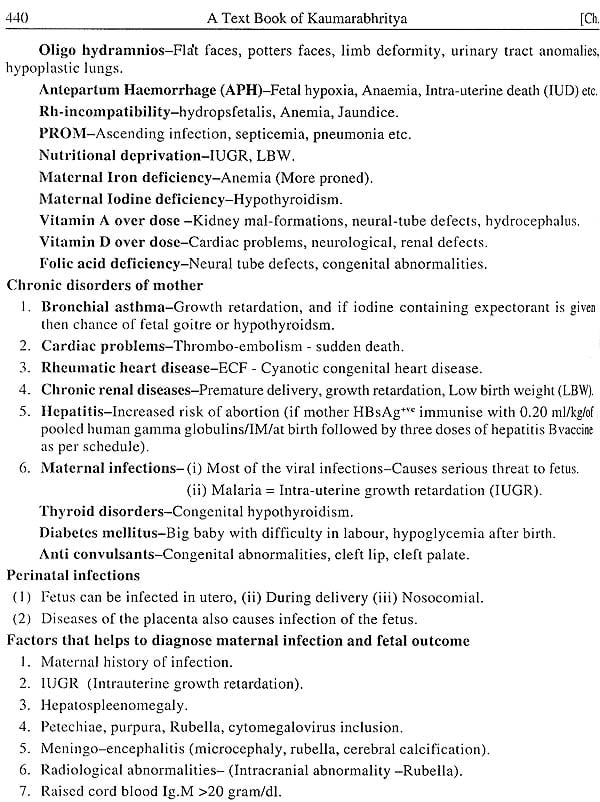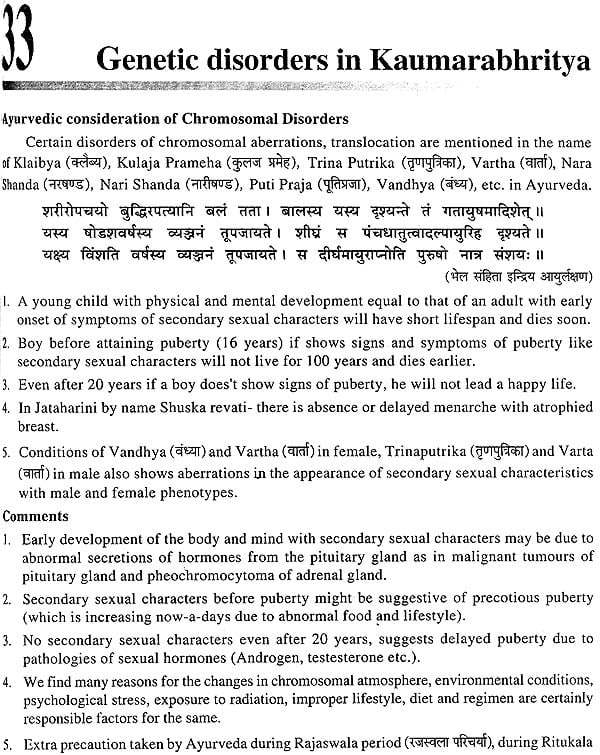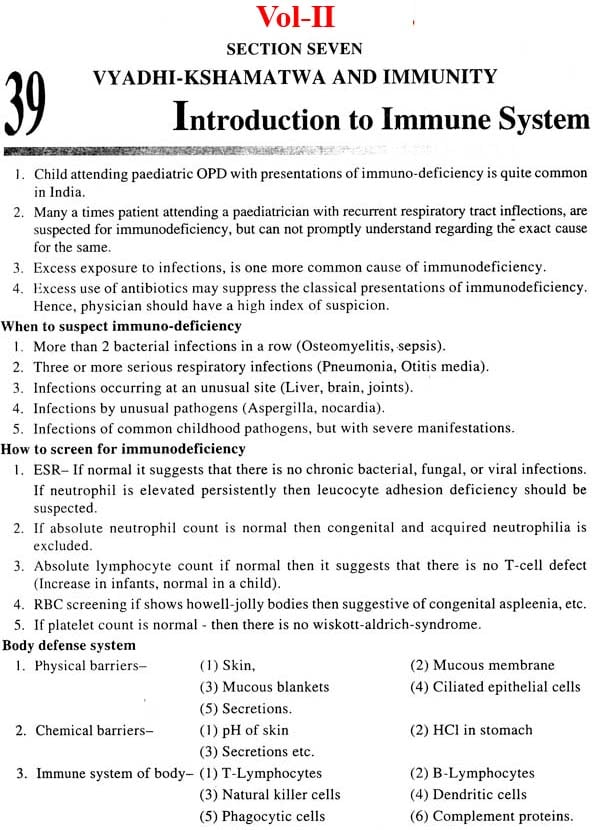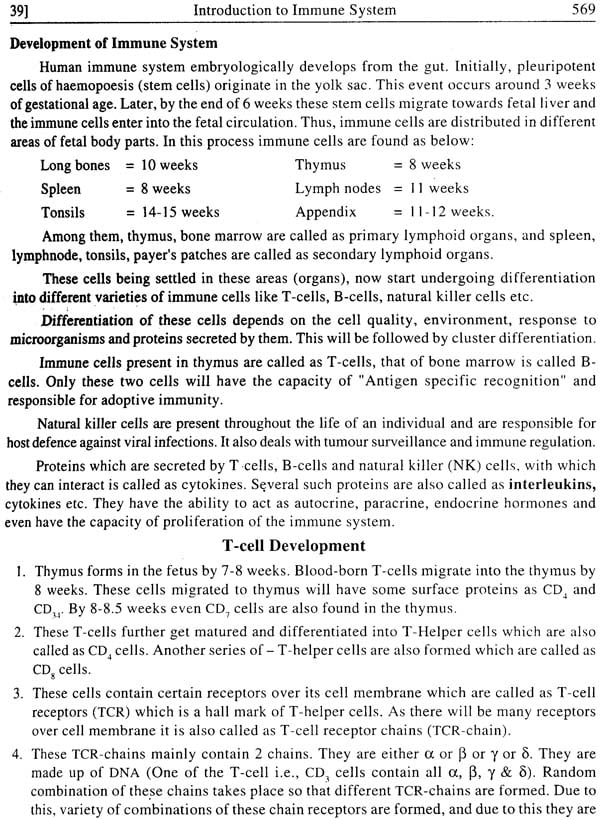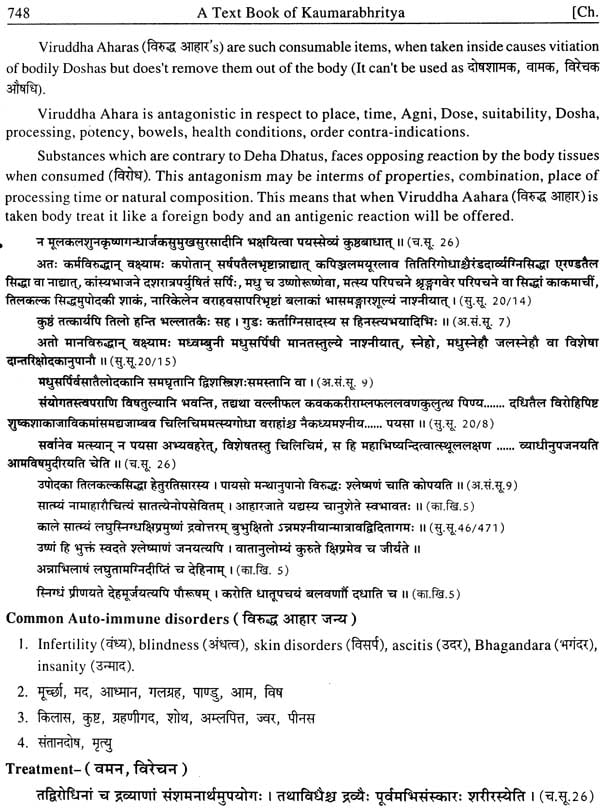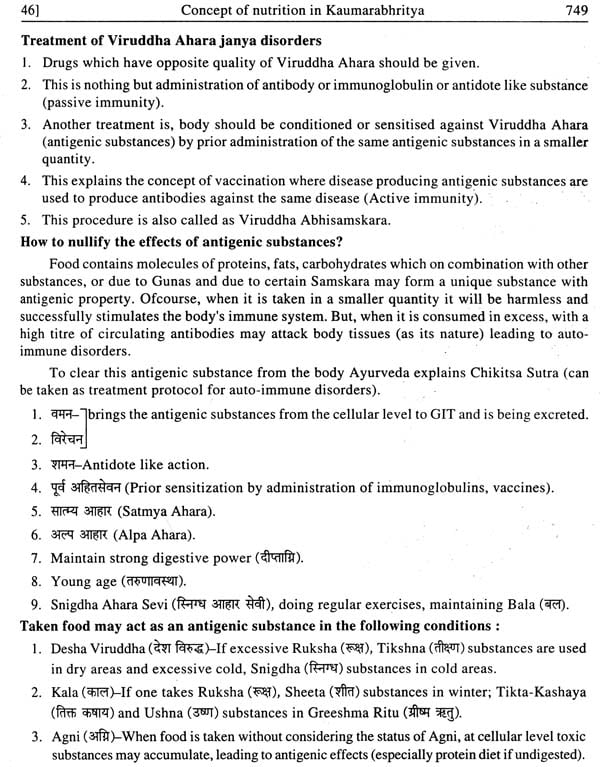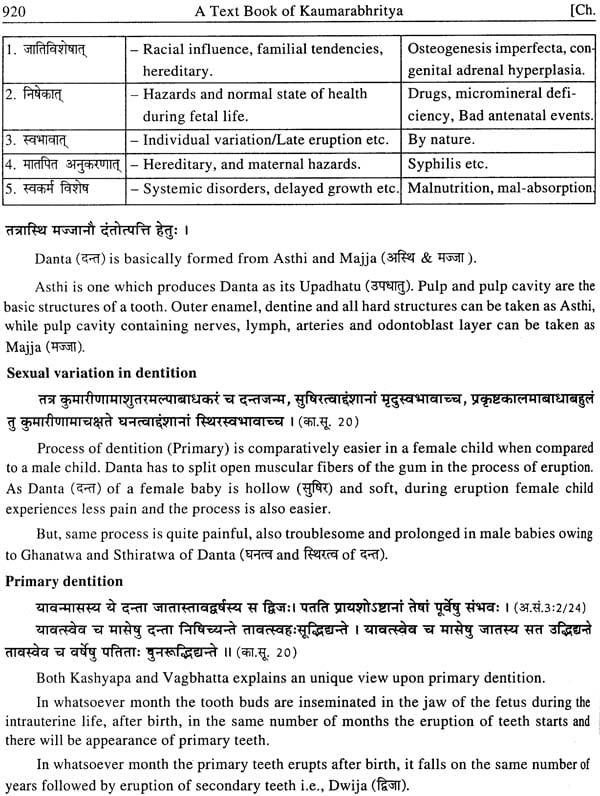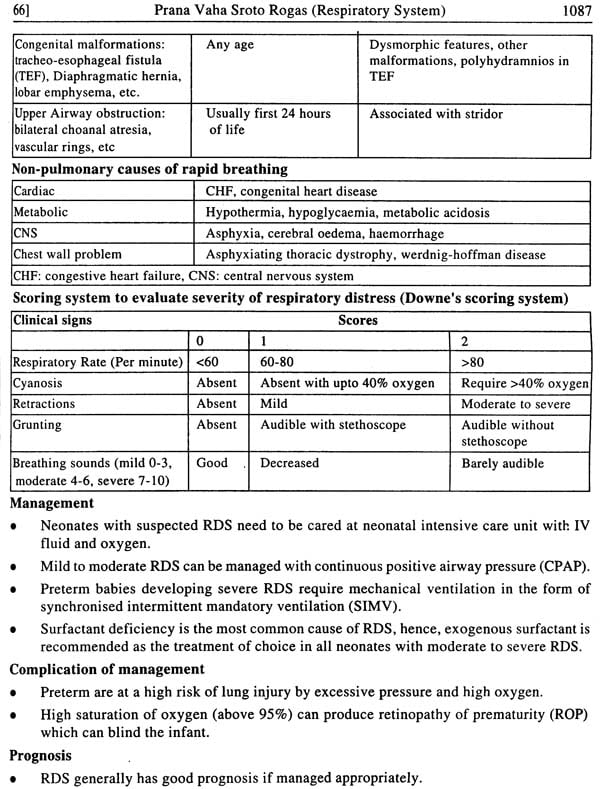
Text Book of Kaumarabhritya (Set of 2 Volumes)
Book Specification
| Item Code: | NAO549 |
| Author: | Dr. Shrinidhi Kumar Acharya |
| Publisher: | CHAUKHAMBHA ORIENTALIA, Varanasi |
| Language: | English |
| Edition: | 2022 |
| ISBN: | Vol-I: 9788176373777 Vol-II: 9788176373845 |
| Pages: | 1248 |
| Cover: | Paperback |
| Other Details | 9.5 incg x 7.5 inch |
| Weight | 1.80 kg |
Book Description
Shrinidhi Kumar Acharya born in traditional middle class Brahmin family on 20-12-1975 in Kudambettu, a remote village in Bantwal Tq, Mangalore district of Karnataka. He is the proud son of K. Venkataramana Acharya & Jayalaxami Acharya. He is married to Smt. Ashalata and has been blessed with two kids (Master Hrishikesh (10) and Master Bhargava (08).
He completed his primary education in Bantwal and later attained his BAMS degree from SDM Ayurvedic college and Hospital Udupi with distinction in all three professionals in 1999. Author completed his post Graduation from prestigious Banaras Hindu University in Subject Kaumarabhritya in 2003 and worked under the guidance Professor R.D. Sharma and Professor B.M. Singh. He attained his Ph.D. from Rajasthan Ayurveda University, Jodhpur under guidance Professor C .M. Jain.
After completion of post graduation he joined the post graduate department of Kaumarabrithya at SDMCA&H at Hassan in 2003 and worked as lecturer and reader till 2010. During this period he is academically and professionally nurtured by Professor C.H.S. Sastry and Professor Prasanna Rao to attain Excellency in the field. Author has been part of many successful programmes launched by SDMCA&H Hassan like Swarna Prashana, and many social and educational programmes.
Later at 2010 he has been selected at post Graduate department of Kaumarabhritya, National Institute of Ayurveda, Jaipur and presently working as assistant professor.
Author is young dynamic multi talented personality with his active involvement in academic, professional, clinical, social, sports and extracurricular activities. He has been regarded as excellent teacher due to his teaching skills, analytical approach, knowledge and oration capacity. He also a successful clinician of Ayurvedic paediatrics and P.G. and Ph.D. Guide and examiner. He has given many interviews, health talk's related s Ayurveda in national 'I'V, and E.T.V. and Radio. He delivered many guest lecturers at different universities and CME etc. Specialty of this book
* Systematic presentation of topics of Kaumarabhritya subject for easy and convenient study.
* Presentation of topics are as per latest C. C.I.M. Syllabus which is beneficial for undergraduates.
* Detail and comprehensive description of topics with scientific analysis with analytical approach for the benefit of post graduates.
* Collection of all possible references of kaumarabhritya scattered in various literatures.
* Scientific analysis of each and every point and its interpretations with reasoning.
* Single and most appropriate opinion of the subject based on explanation of multiple authors. * Development of certain new concepts in topics like Phakka, Graha Roga, Navajatha Shishu Paricharya, Ulbhaka, Dhatri, Samskara etc.
* Certain untouched topics are explored for their practical use Bali, Dhoopana, Stanya Shodana, Putra kamesthi, etc.
* Explanation of practical utility of every topic with its relevance in present paediatrics practice.
* Advantages, disadvantages, limitations, merits of the Ayurvedic approach in child care in comparison to other contemporary medical sciences.
* Point wise presentation with simple language.
* Relevant modern topics are described.
Ayurveda is eternal, scientifically time tested ancient science which has been systematically divided in to eight clinical branches as been evidenced from the literature. Among the eight branches of Ayurveda, Kaumrabhritya or Bala chikitsa has been mentioned with prime importance and compared to Agni Devata. Kashyapa Samhita has been considered as the most authentic book of Kaumarabhritya although we find few chapters related to kaumarabhritya in other Samhitas. Acontemporary Kashyapa Sampradaya also was in practice along with Atreya and Dhanwantari Samparadaya in ancient time although missing of Kashyapa Samhita twice in due course of time and non availability of commentaries badly affected the clinical practice of Kaumarabhritya and had a setback. Ancient Ayurvedic authors struggled a lot to bring Kaumrabhritya in the main stream of Ayurveda by writing several books on Kumarabhritya like Hiranyaksha tantra, Parvataka Tantra etc. which are presently not available.
Pediatric population contribute major portion of patients in clinical practice. An Ayurvedic paediatrician carries the responsibility of producing healthy society as children are future citizen. But, unfortunately less literature and references related to child care and treatment are available in Ayurveda. Hence there is really an urgent need for analysis and comprehensively need rebuilding the subject and teaching methodology of Kaumarabhritya, especially for the benefit of the students and clinicians. Students at undergraduate level and post graduate level really face paucity of a comprehensive text book which includes all references of Kaumarabhritya scattered in different books at a place with comparative analysis as per the need of present clinical practice. Concepts explained in Samhitas need to be upgraded and updated without tampering its originality. Hence, explanation and analysis of Ayurvedic concepts in comparison with other contemporary medical sciences by upholding the Ayurvedic principles helps the student for understanding its practicability and also evoke thought process which explore the hidden medical truth of Ayurveda.
During my student life many a times I felt that principles of Ayurveda were compulsorily loaded over the student like iron balls due to lack of analytical approach. Although Ayurvedic principles are eternal, unchangeable and always fruitful a beginner fail to enjoy the study due to lack of analytical approach and practical application leading to underestimation and ignorance of its glory. Post graduates of Kaumarabhritya also face similar lacunae and find paucity of Ayurvedic explanations and scientific analysis of concepts. It is my long time wish to write such a comprehensive text book of Kaumarabhritya specially keeping interest of those students who have such mind set during their graduation level.
Very less critical analysis has been done on the subject matter of Kaumarabhritya and there were many untouched areas like Graha Rogas, Samskars, Dhatri, Lehana, Phakka avajatha Shishu Paricharya etc. which are not properly understood in relevance to present day context and collective analysis of references of Kaumarabhritya has been missing. Although the childhood clinical practice is a vital, essential clinical branch in other contemporary medical sciences, Ayurvedic paediatrics has not been able to raise to the expected level by extending neonatal and paediatric care.
Hence sincerely I felt the-need of a text book on Kaumarabhritya which critically analyzes the subject of Kaumarabhritya under the light of the present day paediatrics practice so that Ayurvedic Kaumarabhritya can be easily reachable to all, creates interest in learning, augments the thrust of clinical practice, remove the unwanted confusions and helps for flourishing the Ayurvedic Paediatrics i.e. Kaumarabhritya around the globe. Certain childhood disorders which are challenging to the modern world like Cerebral palsy, DMD, Nephrotic syndrome, developmental delay, Mental retardation, childhood obesity and child hood life style related disorders, speech disorders, memory enhancing methods, Immunological disorders can be effectively managed by Ayurvedic paediatrics.
Specialty of this book is, it is easily reachable to all as it is written in a simple language and is given a systematic presentation and therefore undergraduates enjoy reading it. This book give the scope to understand the depth of the subject by evoking an analytical angle of the study of subject as per need of the hour especially for post graduates and Ph.D Scholars. Book will be informative along with pool of references for faculty of Kaumarabrithya and as reference book for practioners. Many a times view of different authors has been analyzed and the most suitable opinion for present situation with clinical application has been explained.
In this book references have been collected from all possible sources by referring different classical Ayurvedic literatures as well as text books of Kaumarabhritya by renowned experts of the field and presented in a very systematic manner to make the study convenient. Each Sloka, words, and disorders are explained with clinical understanding and application. Each concept has been analyzed for its relevance’s in comparison with other contemporary medical sciences. A simple language has been used for easy reading and topics were arranged step wise. Modern explanations were given wherever necessary. Point vise Presentation of the topic has been provided to have comfortable and easy reading.
This book has come out as my 13 years of experience as an undergraduate and post graduate teacher and consultant in the field of Kaumarabhritya which was greatly influenced and enriched by the knowledge and superiority of my teachers at different levels of my academic and professional life. Many explanations, ideas, analysis, references provided in this book are the extension of original ideas of my teachers. I am extremely thankful to Professor C.H.S. Sastrysir who corrected and shaped my professional carrier and kind enough to provide some rare references related to Kaumarabhritya. I always bow my head to the sacred feet of Professor R.D. Sharma, Professor B.M. Singh and professor C.M. Jain sir who guided my academic carrier. I am extremely thankful to Professor. Prasanna Rao, Principal of SDMCA Hassan, and profes or Abhimanyu Kumar, Director, AIIAMS New Delhi for guiding me throughout. I always remember Srinivasa Acharya, Dr. Muralidhara Sharma, Dr. Nagaraj Poojary of SDMCA Udupi for shaping my undergraduate study life.
Explanations, comments, justifications, comparisons, personal views given by me in this book may be incomplete, over explanatory or unjustified as this book is first of its kind. I whole heartedly acknowledge from all for critics, suggestion and better explanations on the subject that I can further incorporate in my next edition.
Contents
| Section One - Introduction Kaumarabhritya | ||
| Chapter -1 | History of Kaumarabhritya | 1-7 |
| Chapter-2 | Definitions of Kaumarabhritya | 8-12 |
| Chapter-3 | Classification of Age in Kaumarbhritya | 13-16 |
| Chapter-4 | Dosage Schedule in Kaumarabhrithya | 17-26 |
| Chapter-5 | Treatment principles in Kaumarabhritya | 27-38 |
| Chapter-6 | Importance and scope of kaumarabhritya | 39-42 |
| Chapter-7 | Clinical Approach in Kaumarabhritya | 43-61 |
| Chapter-8 | Introduction to kashyapa Samhita | 62-72 |
| Section Two-Samskara and Krida in Kumarbrithya | ||
| Chapter-9 | Samskara in Kaumarabhritya | 73-115 |
| Introduciton to Samskara | 73-79 | |
| Jatakarma Samskara | 80-83 | |
| Dolashyana Samskara | 83-85 | |
| Namakarana Samskara | 85-88 | |
| Dugdha pana and Jalapooja Samskara | 88-89 | |
| Suryodaya Darshan and Chandra Darshanaq | 89-90 | |
| Nishkramana Samskara | 90-92 | |
| Anna Prashana - Phala Prashana | 92-96 | |
| Upaveshana Samskara | 96-100 | |
| Karna Vedana Samskara | 100-104 | |
| Chooda Karma | 106-106 | |
| Upanayana Samskara | 106-109 | |
| Akshara Lekhana Samskara | 109-110 | |
| Godhana Samskara | 110-111 | |
| Vivaha Samskara | 111-112 | |
| Varana Banda and Matangi Homa | 112-114 | |
| Procedure of Putra Kamesthi yajgna | 114-115 | |
| Chapter-10 | Krida in Kaumarbhritya | 116-125 |
| Kidanaka and Krida Bhumi | 115-112 | |
| Modern concept of Play | 121-123 | |
| Concept of Play school and Playing skills | 123-125 | |
| Chapter-11 | Concept of Kumaradhara | 126-132 |
| Kamaradhara and his qualities | 128-132 | |
| Method of child care by Kumaradhara | 133-136 | |
| Chapter-12 | Concept of Kumaragara | 133-136 |
| Construction of Kamaragara as per Ayurveda | 133-134 | |
| Construction of neonatal care unit | 134-136 | |
| Section Three: Pancha Karma in Kaumarabhritya | 78 | |
| Chapter-13 | Snehana in Kaumarabhritya | 137-142 |
| Chapter-14 | Diet Modification in paediatric Pancha Karma | 143-145 |
| Chapter-16 | Combinations of Different Rasa | 146-147 |
| Chapter-17 | Swedana in Kaumarabhritya | 148-150 |
| Chapter-17 | General Introduction toShodana | 151-154 |
| Chapter-18 | Vamana Karma in Kaumarabhritya | 155-157 |
| Chapter-19 | Virechana Karma in Kaumarabhritya | 158-160 |
| Chapter-20 | Basti in Kaumarabhritya | 161-172 |
| Chapter-21 | Nasya in Kaumarabhritya | 173-175 |
| Section Four: Graha-Rogas in Kaumarabhritya | ||
| Chapter-22 | General concept and Treatment | 176-254 |
| Introduction to Graha Roga, Graha Badha | 176-177 | |
| Graha and its similarities with microorganisms | 177-180 | |
| History origin types causes symptoms of Graha Roga | 180-195 | |
| General Treatment of Graha Roga | 195 | |
| Daiva Vyapashraya Chikitsa, and Mantra in Graha Roga | 196-199 | |
| Yukti Vyapashraya Chikitsa, in Graha Roga | 199-201 | |
| Dhoopana or Fumigation in Graha Roga | 201-206 | |
| Bali Chikitsa in Graha Roga with its scientific understanding | 206-211 | |
| Understanding of Skanda Graha and its treatment | 211-215 | |
| Understanding of Skanda Apasmara and its treatment | 215-219 | |
| Understanding of Naigamesha Graha and Its treatment | 219-222 | |
| Understanding of Shakuni Graha and Its Treatment | 223 | |
| Understanding of Putana, Andha Putana Sheeta Putana Graha and its treatment | 224-235 | |
| Understanding Mukha Mandika and Its treatment | 235-238 | |
| Understanding of Revati Graha and Its treatment | 238-250 | |
| Understanding of Shwa Graha and its treatment | 251-253 | |
| Understanding of Pitru Graha and Its Treatment | 252-253 | |
| Understanding of Shushka Revati and Its Treatment | 253-254 | |
| Section Five: Neonatology | ||
| Chapter-23 | Basics of Neonatology | 255-278 |
| Definitions and nomenclature in neonatology | 255-258 | |
| Examination of New Born | 259-265 | |
| Assessment of Gestational age, reflexes and anthropometry | 265-278 | |
| Chapter-24 | Ayurvedic Approach to examination of Newborn | 279-306 |
| Protocol for Ayurvedic Approach to Examination of Newborn | 296-306 | |
| Chapter-25 | New Born Care | 307-329 |
| How to receive the baby | 307-309 | |
| Navajatha Shishu Paricharya Introduction | 309-310 | |
| Nala Chedana | 311-313 | |
| Mukha-Vishodana, Pichu Dharana, Ulbha Parimarjna | 313-316 | |
| Neonatal Bath - Shishu Snana | 316 | |
| Baby Massage-shishu Abhyanga | 317-318 | |
| Jatakarma Samskara and Garbodaka Vamana | 318-320 | |
| Aseptic living condition for newborn - Kumara Raksha vidhi | 320-324 | |
| Mani Dharana, Baby bed (shishu Shayya) | 324-326 | |
| Neonatal care in book-Arogya Kalpa Druma | 326-329 | |
| Chapter-26 | Activities of the Baby after Birth | 330-334 |
| Chapter-27 | Resuscitation of Sick newborn | 335-347 |
| Introduction to instruments used in Resuscitation | 345-347 | |
| Chapter-28 | Resuscitation in Ayurveda (Prana Prathyagamana) | 348-364 |
| Condition which demands -Prana Prathyagamana | 348-351 | |
| Resuscitation in Ayurveda-stimulation of Respiration | 352-364 | |
| Chapter-29 | disorders of Weight and Gestation | 365-381 |
| Preterm baby (modern and Ayurvedic concepts) | 365-369 | |
| Small for gestational age (modern and Ayurvedic concepts) | 369-374 | |
| Post term baby (Modern and Ayurvedic concepts) | 374-375 | |
| Twin Babies (modern and ayurvedic concepts) | 376-378 | |
| Management of extremely Low birth weight babies | 378-380 | |
| Feeding in Low birth weight babies as per ayurveda | 380-381 | |
| Chapter-30 | Neonatal Symptomolgy | 382-405 |
| Vedana Adhyaya | 382-391 | |
| Protocol for assessment of Vedana Adhyaya | 391-394 | |
| Common neonatal problems | 395-405 | |
| Chapter-31 | Neonatal disorders | 406-435 |
| Ulbhaka and meconium aspiration Syndrome | 406-409 | |
| Upasheerashaka | 409-409 | |
| Prasava Kala Abhigathaja vyadhi (Birth Injuries) | 410-411 | |
| Septicemia and Jatha Harini | 412-416 | |
| Radana and Navajatha Shishu Chardhi | 416-418 | |
| Disorders of newborn like, Rashes, Sadanta Janma, pale baby | 418-422 | |
| Disorder of temperature Regulation-Hypothermia | 422-425 | |
| Navajatha Shishu Kamala | 425-431 | |
| Navajatha Netra Abhishayandata | 431-432 | |
| Rakta Vishamayata | 432-433 | |
| Rakta Sravi vikara (Neonatal Bleeding isorders) | 433-434 | |
| Chapter-32 | Ayurvedic concept of fetal monitoring | 436-440 |
| Chapter-33 | Genetic disorders in Kaumarabhritya | 441-454 |
| Ayurvedic consideration of genetic disorders | 441-444 | |
| Juvenile diabetes mellitus | 441-446 | |
| Thalassemia | 446-448 | |
| Sickle cell disease | 448-450 | |
| Down's syndrome | 450-451 | |
| Turner's syndrome | 451-452 | |
| Klinefelter's Syndrome | 452 | |
| Muscular Dystrohy | 452-454 | |
| Chapter-34 | Infectious Disorders in Kaumarabhritya | 455-483 |
| Chicken pox and romantika | 455-458 | |
| Measles and Masurika | 458-461 | |
| Typhoid fever and Antrika Jwara | 463-466 | |
| Malaria | 466-469 | |
| Neonatal meningitis | 469-471 | |
| Tuberculosis | 471-476 | |
| Dengue fever | 477-478 | |
| HIV in Children | 478-479 | |
| Tetanus | 480 | |
| Diphtheria | 481-482 | |
| Pertussis | 482-483 | |
| Section Six: Feeding and Nutrition in Kaumarabhritya | ||
| Chapter-35 | Feeding and Nutrition in Kaumarabhritya | 484-543 |
| General Introduction to Stanya and its qualities, Vridhi, Kashya, stanya sampath etc | 484-489 | |
| Examination of Stanya (Breast milk), Indication and contraindication of breast feeding | 490-492 | |
| Concept of Animal milk | 492-503 | |
| Modern concept of Breast milk Reflexes, advantages, indications, Contraindications, Adquacy immunology, role of breast milk in brain growth, difference with other animal milk etc. | 503-514 | |
| Concept of artificial milk feeding in Ayurveda-Stanya abave Kimdeyam | 514-516 | |
| Modern concept of Artificial milk feeding | 516-518 | |
| Breast feeding method | 518-519 | |
| Common problems of breast milk feeding | 520-521 | |
| common Breast feeding problems as per Ayurveda | 521-523 | |
| Breast milk Vitiation and its causes | 523-524 | |
| Pancha Kasheera Dosha as per Hareetha | 524-526 | |
| Asta vidha Stanya dusti and symptomatology as per charaka and its treatment | 526-543 | |
| Chapter-36- | Concept of Dhatri in Ayurveda | 544-556 |
| Introduction and Examination of Dhatri and its importance | 544-551 | |
| Dhatri Chikitsa | 551-554 | |
| Understanding concept of Dhatri in present day practice | 554-556 | |
| Chapter-37 | Concept of Stanya Shodana and Vardhana in Ayurveda | 557-562 |
| Chapter-38 | Weaning Stanyapanayana | 563-567 |
| Ayurvedic concept of weaning | 563-567 | |
| Modern concept of weaning | 565-567 | |
| Major Books Referred | I-III | |
| Index | IV-XXV |
| | ||
| Chapter-39 | Introduction to Immune System | 568-582 |
| Chapter-40 | Basics of Vaccination | 583-616 |
| Chapter-41 | Immunization in special situations | 617-629 |
| Chapter-42 | Concept of immune system in Ayurveda | 630-659 |
| Chapter-43 | Lehana in Kaumarbhritya | 660-671 |
| Chapter-44 | Practical Implementation of Swrana Prashana | 672-679 |
| | ||
| Chapter-45 | Introduction to carbohydrate, Fat, Proteins, Vitamins, and Micro nutrients | 680-719 |
| Chapter-46 | Concept of Nutrition inKaumarabhritya | 719-752 |
| | ||
| Chapter-47 | Fetal growth and development (Garbhavakranthi) | 753-791 |
| Chapter-48 | Normal growth and assessment | 792-800 |
| Chapter-49 | Assessment of growth and development in Ayurveda | 801-809 |
| | ||
| Chapter-50 | Eye disorders in Kaumarabhritya | 810-826 |
| Chapter-51 | Speech disorders in Kaumarbhritya | 827-835 |
| Chapter-52 | Mukha Rogas issn Kaumarbhritya | 836-844 |
| Chapter-53 | Skin Disorders in Kaumarbrithya | 845-871 |
| Chapter-54 | Shiro-Rogas in Kaumarabhritya | 872-882 |
| Chapter-55 | Neurological disorders | 883-902 |
| Chapter-56 | Congenital Mal formations | 903-913 |
| Chapter-57 | Danta and Danthodbedha Vyadhis (Dentition and Dentition Disorders) | 914-935 |
| Chapter-58 | Nabhi Roags in Kaumarabhritya | 936-941 |
| Chapter-59 | Guda Rogas in Kaumarbhritya | 942-949 |
| Chapter-60 | Krimi Rogas in Kaumarabhritya | 950-961 |
| Chapter-61 | Pleeha Rogas in Kaumarbhritya (Disorders of Spleen and liver) | 962-981 |
| Chapter-62 | Nutritional disorders in Ayurveda-Kuposhana Janya vyadhis | 982-1013 |
| Chapter-63 | Mutra Vaha Sroto Rogas in Kaumarabhritya-Urinary disorders | 1014-1029 |
| Chapter-64 | Manasika Rogas in Kaumarbhritya | 1030-1066 |
| Chapter-65 | Conceptof ayurvedic counselling by Satwavajya Chikitsa | 1068-1083 |
| Chapter-66 | Pranavaha Sroto Rogas-disorders of Respiratory system | 1084-1099 |
| Chapter-67 | Annavaha Sroto Rogas | 1100-1114 |
| chapter-68 | Rasavaha Sroto Rogas | 1115-1120 |
| Chapter-69 | Disorders of Mamsa and Medhovaha Rogas | 1121-1128 |
| Chapter-70 | Disorders of Cardio Vascular System | 1129-1134 |
|
| ||
| Chapter-71 | Life saving measures (Emergency Treatment) | 1135-1142 |
| Chapter-72 | Fluid and electrolyte therapy in children | 1143-1158 |
| | ||
| Chapter-73 | Knowledge of chid health policy measures | 1159-1167 |
